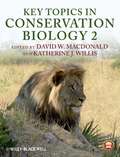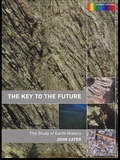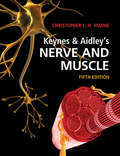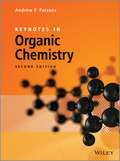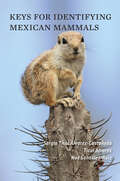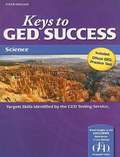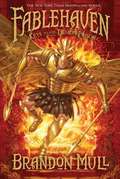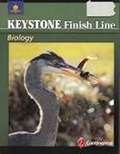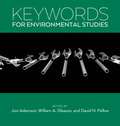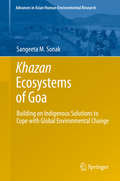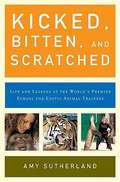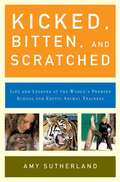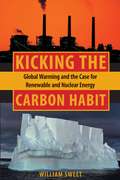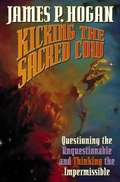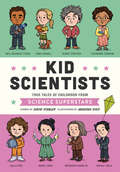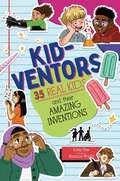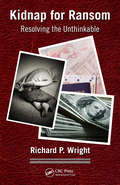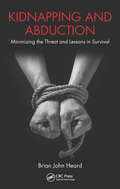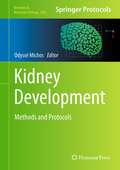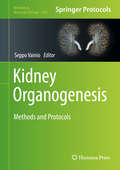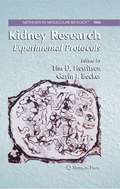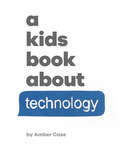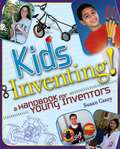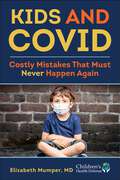- Table View
- List View
Key Topics in Conservation Biology 2
by David W. MacdonaldFollowing the much acclaimed success of the first volume of Key Topics in Conservation Biology, this entirely new second volume addresses an innovative array of key topics in contemporary conservation biology. Written by an internationally renowned team of authors, Key Topics in Conservation Biology 2 adds to the still topical foundations laid in the first volume (published in 2007) by exploring a further 25 cutting-edge issues in modern biodiversity conservation, including controversial subjects such as setting conservation priorities, balancing the focus on species and ecosystems, and financial mechanisms to value biodiversity and pay for its conservation. Other chapters, setting the framework for conservation, address the sociology and philosophy of peoples’ relation with Nature and its impact on health, and such challenging practical issues as wildlife trade and conflict between people and carnivores. As a new development, this second volume of Key Topics includes chapters on major ecosystems, such as forests, islands and both fresh and marine waters, along with case studies of the conservation of major taxa: plants, butterflies, birds and mammals. A further selection of topics consider how to safeguard the future through monitoring, reserve planning, corridors and connectivity, together with approaches to reintroduction and re-wilding, along with managing wildlife disease. A final chapter, by the editors, synthesises thinking on the relationship between biodiversity conservation and human development. Each topic is explored by a team of top international experts, assembled to bring their own cross-cutting knowledge to a penetrating synthesis of the issues from both theoretical and practical perspectives. The interdisciplinary nature of biodiversity conservation is reflected throughout the book. Each essay examines the fundamental principles of the topic, the methodologies involved and, crucially, the human dimension. In this way, Key Topics in Conservation Biology 2, like its sister volume, Key Topics in Conservation Biology, embraces issues from cutting-edge ecological science to policy, environmental economics, governance, ethics, and the practical issues of implementation. Key Topics in Conservation Biology 2 will, like its sister volume, be a valuable resource in universities and colleges, government departments, and conservation agencies. It is aimed particularly at senior undergraduate and graduate students in conservation biology and wildlife management and wider ecological and environmental subjects, and those taking Masters degrees in any field relevant to conservation and the environment. Conservation practitioners, policy-makers, and the wider general public eager to understand more about important environmental issues will also find this book invaluable.
Key to The Future: The History of Earth Science
by John CaterHere is a book for everyone who has an interest in how our planet works, what has happened during its 4,550 million year history and what might happen in the future. It tells how Earth scientists study the pattern of events that have shaped the planet and guided the evolution of life on Earth. In clear and simple language it describes how the effec
Keynes & Aidley's Nerve and Muscle
by Christopher L.-H. HuangThis well-established and acclaimed textbook introducing the rapidly growing field of nerve and muscle function has been completely revised and updated. Written with undergraduate students in mind, it begins with the fundamental principles demonstrated by the pioneering electrophysiological experiments on cell excitability. This leads to more challenging material recounting recent discoveries from applying modern biochemical, genetic, physiological and biophysical, experimental and mathematical analysis. The resulting interdisciplinary approach conveys a unified contemporary understanding of nerve and skeletal, cardiac and smooth muscle function at the molecular, cellular and systems levels. Emphasis on important strategic experiments throughout clarifies the basis for our current scientific views, highlights the excitement and challenge of biomedical discovery, and suggests directions for future advances. These fundamental ideas are then translated into discussions of related disease conditions and their clinical management. Now including colour illustrations, it is an invaluable text for students of physiology, neuroscience, cell biology and biophysics.
Keynotes in Organic Chemistry
by Andrew F. ParsonsThis concise and accessible book provides organic chemistry notes for students studying chemistry and related courses at undergraduate level, covering core organic chemistry in a format ideal for learning and rapid revision. The material is organised so that fundamental concepts are introduced early, then built on to provide an overview of the essentials of functional group chemistry and reactivity, leading the student to a solid understanding of the basics of organic chemistry. Graphical presentation of information is central to the book, to facilitate the rapid assimilation, understanding and recall of critical concepts, facts and definitions.Students wanting a comprehensive and accessible overview of organic chemistry to build the necessary foundations for a more detailed study will find this book an ideal source of the information they require. In addition, the structured presentation, highly graphical nature of the text and practice problems with outline answers will provide an invaluable framework and aid to revision for students preparing for examinations. Keynotes in Organic Chemistry is also a handy desk reference for advanced students, postgraduates and researchers.For this second edition the text has been completely revised and updated. Colour has been introduced to clarify aspects of reaction mechanisms, and new margin notes to emphasise the links between different topics. The number of problems have been doubled to approximately 100, and includes spectra interpretation problems. Each chapter now starts with diagrams to illustrate the key points, and ends with a list of key reactions and a worked example.
Keys for Identifying Mexican Mammals
by Sergio Ticul Álvarez-Castañeda Ticul Álvarez Noé González-RuizFully updated and revised, this is the bestselling comprehensive bilingual identification guide to Mexico’s diverse mammalian fauna.A remarkable achievement that took over 30 years to construct, Keys for Identifying Mexican Mammals is the only complete identification guide to Mexico’s mammalian fauna. Fully updated and revised, this bestselling book follows a bilingual arrangement, with identical information presented in Spanish and English on facing pages. The dichotomous presentation is both easy to follow and flawlessly compiled, including updated and expanded material that surpasses any previously available resource. Hundreds of diagnostic images are dispersed throughout the book, many showing minute details that differentiate one species from another, and introductory materials carefully explain the use of diagnostic features. The heart of the book, though, is the keys themselves, which cover every taxa—from artiodactyls and carnivores to primates and rodents—while allowing confident identification at the species level for both field and museum use. The book closes with appendices that cover preparation of specimens, a glossary, and a bibliography. Anyone with an interest in the mammalian fauna of Mexico, or mammals in general, will find this one-of-a-kind book an indispensable reference to Mexico’s rich diversity of wildlife.
Keys to GED Success: Science
by Steck-VaughnThis book focuses on the thinking and graphic interpretation skills needed to pass the GED Science Test.
Keys to the Demon Prison (Fablehaven Series, Book #5)
by Brandon MullFor centuries, mystical creatures of all description were gathered in a hidden refuge called Fablehaven to prevent their extinction. The sanctuary survives today as one of the last strongholds of true magic in a cynical world.
Keystone Finish Line: Biology Workbook
by Continental Press StaffGive your students every chance for success with Keystone Finish Line Biology. This workbook reviews Pennsylvania's Assessment Anchors and Eligible Content of the Keystone Biology Exam, and familiarizes students with the format of tested question types. Practice questions range in difficulty, with many Depth of Knowledge (DOK) levels 2 and 3 items that call for higher-order reasoning. Supportive illustrations, graphs, and artwork build on concepts. Units include multiple-choice items and rigorous constructed-response problems that test multiple anchors. A review section at the end of each module can be used as a practice test. Practice questions are frequently posed in real-life contexts. Learning support includes reminders and examples for illustration. Students will also see guided examples with explanations that show how to find the answer in a logical way. A glossary of important terms is included.
Keywords for Environmental Studies (Keywords #3)
by David N. Pellow William A. Gleason Joni AdamsonIntroduces key terms, quantitative and qualitative research, debates, and histories for Environmental and Nature StudiesUnderstandings of “nature” have expanded and changed, but the word has not lost importance at any level of discourse: it continues to hold a key place in conversations surrounding thought, ethics, and aesthetics. Nowhere is this more evident than in the interdisciplinary field of environmental studies. Keywords for Environmental Studies analyzes the central terms and debates currently structuring the most exciting research in and across environmental studies, including the environmental humanities, environmental social sciences, sustainability sciences, and the sciences of nature. Sixty essays from humanists, social scientists, and scientists, each written about a single term, reveal the broad range of quantitative and qualitative approaches critical to the state of the field today. From “ecotourism” to “ecoterrorism,” from “genome” to “species,” this accessible volume illustrates the ways in which scholars are collaborating across disciplinary boundaries to reach shared understandings of key issues—such as extreme weather events or increasing global environmental inequities—in order to facilitate the pursuit of broad collective goals and actions. This book underscores the crucial realization that every discipline has a stake in the central environmental questions of our time, and that interdisciplinary conversations not only enhance, but are requisite to environmental studies today.Visit keywords.nyupress.org for online essays, teaching resources, and more.
Khazan Ecosystems of Goa
by Sangeeta M. SonakThis book elaborates on the Khazan ecosystems of Goa, India. Khazans are human-managed ecosystems, which are reclaimed from coastal wetlands, salt marshes and mangrove areas, where tidal influence is regulated through a highly structured system of dykes, canals, furrows, and sluice gates using resources that are amply available locally. Khazan ecosystems are marvels of tribal engineering. They are a simple architectural design, which operate at a very low running cost using tidal, hydro, and solar energy. The design contributes to a highly complex but eco-friendly ecosystem integrating agriculture, aquaculture and salt panning. . Khazan ecosystems have been functional for the last 3500 years. The history of Khazans is very ancient and can be traced to the transition from food gathering to food growing, which has been regarded as the biggest step in the history of human civilization. Khazan ecosystems thus have a high historical and world heritage value. They are also repositories of global biodiversity, with unique flora suitable to their unique and highly variable environment. They are endemic and heritage ecosystems of Goa and ultimately reservoirs of history and heritage. Using the example of the Khazan lands, the book analyzes and comments on traditional ecological knowledge and indigenous technology. It presents the evolution of Khazan management institutions over a period of more than three thousand years, as well as factors that have contributed to its decline in recent years It develops a conceptual framework for ecosystem performance and suggests strategies for conservation of Khazans as well as strategies to build on these indigenous adaptation mechanisms to cope with the global environmental change.
Kicked, Bitten, and Scratched
by Amy SutherlandA rare and absolutely enchanting look inside the Harvard of wild animal wranglers As is obvious to anyone who has read her most e-mailed New York Times article of 2006, ?What Shamu Taught Me About a Happy Marriage,? Amy Sutherland knows a thing or two about animals. In Kicked, Bitten, and Scratched, she takes readers behind the gates of Moorpark Community College, where students are taught such skills as how to train a hyena to pirouette and coax a tiger to open wide for a vet exam. As she follows the faculty, student body, and four- footed teaching aides at Moorpark?s Exotic Animal Training and Management program, Sutherland produces a true walk on the wild side, filled with wonder, comedy, occasional heartache, and transcendent beauty. .
Kicked, Bittten, and Scratched: Life and Lessons at the World's Premier School for Exotic Animal Trainers
by Amy SutherlandWalking cougars on leashes, teaching a mandrill to get an injection, working with elephants, and teaching rats to run up mazes are some of the things students in the Exotic Animal Training and Management program do at Moore Park College. Follow the "first year" students as they learn and grow to develop confidence in handling animals and improve their ways of managing each other. Good read for anyone interested in any type of animal training.
Kicking the Carbon Habit: Global Warming and the Case for Renewable and Nuclear Energy
by William SweetWith glaciers melting, oceans growing more acidic, species dying out, and catastrophic events like Hurricane Katrina ever more probable, strong steps must be taken now to slow global warming. Further warming threatens entire regional economies and the well being of whole populations, and in this century alone, it could create a global cataclysm. Synthesizing information from leading scientists and the most up-to-date research, science journalist William Sweet examines what the United States can do to help prevent climate devastation.Rather than focusing on cutting oil consumption, which Sweet argues is expensive and unrealistic, the United States should concentrate on drastically reducing its use of coal. Coal-fired plants, which currently produce more than half of the electricity in the United States, account for two fifths of the country's greenhouse gas emissions of carbon dioxide into the atmosphere. Sweet believes a mixture of more environmentally sound technologies-wind turbines, natural gas, and nuclear reactors-can effectively replace coal plants, especially since dramatic improvements in technology have made nuclear power cleaner, safer, and more efficient.Sweet cuts through all the confusion and controversies. He explores dramatic advances made by climate scientists over the past twenty years and addresses the various political and economic issues associated with global warming, including the practicality of reducing emissions from automobiles, the efficacy of taxing energy consumption, and the responsibility of the United States to its citizens and the international community to reduce greenhouse gases. Timely and provocative, Kicking the Carbon Habit is essential reading for anyone interested in environmental science, economics, and the future of the planet.
Kicking the Sacred Cow: Questioning the Unquestionable and Thinking the Impermissible
by James P. HoganScientists are Only Human, and Not Immune to Dogma. A New York Times Best-selling Writer Examines the Facts in the Most Profound Controversies in Modern Science. Galileo may have been forced to deny that the Earth moves around the Sun; but in the end, science triumphed. Nowadays science fearlessly pursues truth, shining the pure light of reason on the mysteries of the universe. Or does it? As best-selling author James P. Hogan demonstrates in this fact-filled and thoroughly documented study, science has its own roster of hidebound pronouncements which are Not to be Questioned. Among the dogma-laden subjects he examines are Darwinism, global warming, the big bang, problems with relativity, radon and radiation, holes in the ozone layer, the cause of AIDS, and the controversy over Velikovsky. Hogan explains the basics of each controversy with his clear, informative style, in a book that will be fascinating for anyone with an interest in the frontiers of modern science. This book also discusses Asbestos and why the Twin-Towers should have stood for hours, long enough for most to have escaped. He also takes up the CFC Controversy and the myths about DDT. False Science costs lives, especially in the third world.
Kid Innovators: True Tales of Childhood from Inventors and Trailblazers (Kid Legends #7)
by Robin StevensonMoving, funny, and totally true childhood biographies of Bill Gates, Madam C. J. Walker, Hedy Lamarr, Walt Disney, and 12 other international innovators. Throughout history people have experimented, invented, and created new ways of doing things. Kid Innovators tells the stories of a diverse group of brilliant thinkers in fields like technology, education, business, science, art, and entertainment, reminding us that every innovator started out as a kid. Florence Nightingale rescued baby mice. Alan Turing was a daydreamer with terrible handwriting. And Alvin Ailey felt like a failure at sports. Featuring kid-friendly text and full-color illustrations, readers will learn about the young lives of people like Grace Hopper, Steve Jobs, Reshma Saujani, Jacques Cousteau, the Wright Brothers, William Kamkwamba, Elon Musk, Jonas Salk, and Maria Montessori.
Kid Scientists: True Tales of Childhood from Science Superstars (Kid Legends #5)
by David Stabler Anoosha SyedFrom the author who brought young readers KID ATHLETES, KID PRESIDENTS, KID ARTISTS, and KID AUTHORS comes KID SCIENTISTS, a lively look into the childhoods of the world's most brilliant scientists.
Kid-ventors: 35 Real Kids and their Amazing Inventions
by Kailei PewWhat do swim fins, Popsicles®, Infection-Detecting Stitches, the Braille alphabet, and Taco vs. Burrito all have in common? They were all invented by kids! When Remya Jose had to spend many hours washing her family’s laundry by hand, she invented a pedal powered washing machine that could finish the chore in only 20 minutes! When Tripp Phillips’ Lego creations kept falling apart, he developed a glue strong enough to hold his creations together that would wash off when he was ready to build something new! And when Fatima Al Kaabi didn’t have anyone willing to teach her about robotics, she turned to the internet to teach herself all the skills she needed—and created multiple crowd-pleasing robots in the process! From Popsicles® and swim fins to robots and glitter shooting prosthetics, Kailei Pew's middle grade nonfiction debut is full of fun and inspiring stories, illustrated by Shannon Wright, about real kid inventors who proved that even the youngest people can change the world.
Kidnap for Ransom: Resolving the Unthinkable
by Richard P. WrightThe enormous sums paid for the release of hostages coupled with law enforcement‘s inability to stem the tide has made kidnapping for ransom a worldwide plague. The increasing rate of reported incidents from every corner of the globe suggests this plague is growing. Kidnap for Ransom: Resolving the Unthinkable removes the veil of mystery and dispels
Kidnapping and Abduction: Minimizing the Threat and Lessons in Survival
by Brian John HeardTerrorist groups and organized crime cartels pose an increasing threat of kidnapping throughout many regions in the word. At the same time, international travel has become more commonplace for both business and leisure purposes. Kidnapping and Abduction: Minimizing the Threat and Lessons in Survival provides a practical guide on the precautions tra
Kidney Development
by Odyssé MichosOver the last decade the development of new molecular biology tools, advanced microscopy, live imaging and systems biology approaches have revolutionized our conception of how embryonic development proceeds. One fundamental aspect of development biology is the concept of morphogenesis: understanding how a group of multipotent cells organize and differentiate into a complex organ. In Kidney Development: Methods and Protocols, expert researchers in the field detail different approaches to tackle kidney development. These approaches include culture and live imaging aspects of kidney development, analyzing the 3-dimensional aspects of branching morphogenesis as well as nephrogenesis, manipulation of the gene/protein expression during kidney development as well as in the adult kidney, and how to assess kidney malformation and disease. Written in the highly successful Methods in Molecular BiologyTM series format, chapters include introductions to their respective topics, lists of the necessary materials and reagents, step-by-step, readily reproducible laboratory protocols, and key tips on troubleshooting and avoiding known pitfalls. Authoritative and practical, Kidney Development: Methods and Protocols seeks to aid scientists in the further study of the process of morphogenesis which is fundamental important not only for studying developmental biology but also for regenerative medicine.
Kidney Organogenesis: Methods And Protocols (Methods In Molecular Biology #1926)
by Seppo VainioThis book details protocols on classical methods and very modern ex vivo mammalian developmental kidney model systems. Chapters focus on generation of mosaic embryonic kidneys, culture of the kidney tissues ex vivo, embryonic kidney progenitor cell, 3Dkidney model cell line based cultures, programming the kidney cell fates in human pluripotent cells, protocols to target the functional players in kidney ontogenesis, 4D and 3D ex vivo imaging, drosphila, and computational approaches to kidney ontogenesis. Written in the highly successful Methods in Molecular Biology series format, chapters include introductions to their respective topics, lists of the necessary materials and reagents, step-by-step, readily reproducible laboratory protocols, and tips on troubleshooting and avoiding known pitfalls. <p><p> Authoritative and cutting-edge, Kidney Organogenesis: Methods and Protocols aims to ensure successful results in the further study of this vital field.
Kidney Research
by Tim D. Hewitson Gavin J. BeckerAs the expense of treating a growing number of end-stage kidney disease patients increases, greater attention has been paid to prevention and early treatment. The study of renal disease, however, suffers due to the complex nature of renal anatomy and physiology and the plethora of different cell types found in the kidney. In Kidney Research: Experimental Protocols, top experts in the field seek to aid researchers by providing a number of specialized techniques developed to examine this intricate system. Through both well-established and novel methods, this volume explores the preparation and culture of the main cell types used to study renal disease mechanisms, the common animal models used to mimic the various forms of human renal disease, and specific applications and techniques used in vivo and in vitro. Written in the highly successful Methods in Molecular BiologyTM series format, the chapters contain step-by-step, readily reproducible laboratory protocols, lists of the necessary materials and reagents, and tips on troubleshooting and avoiding known pitfalls. Essential and cutting-edge, Kidney Research: Experimental Protocols delivers invaluable guidance to new and experienced laboratory researchers delving into the sophisticated study of the kidney.
Kids Book About Technology, A (A Kids Book)
by Amber CaseBuild a healthy relationship with the technology in your life!We're all cyborgs. It's true! We use technology every day in all aspects of our lives—but that's not a bad thing! The problem is when we let it take over our lives. This book will help kids and grownups alike reflect on their relationship with technology and learn to embrace the benefits of being unplugged.
Kids Inventing!
by Susan CaseyHave you ever seen inventors on TV or in the newspaper and thought, "That could be me!" Well, it certainly could-and this book shows you how. Kids Inventing! gives you easy-to-follow, step-by-step instructions for turning your ideas into realities for fun, competition, and even profit. From finding an idea and creating a working model to patenting, manufacturing, and selling your invention, you get expert guidance in all the different stages of inventing. You'll see how to keep an inventor's log, present your ideas, and work as part of a team or with a mentor. You'll meet inspiring kids just like you who designed their own award-winning inventions. And you'll see how to prepare for the various state and national invention contests held each year, as well as international competitions and science fairs.
Kids and COVID: Costly Mistakes That Must Never Happen Again
by Elizabeth MumperKids and COVID provides an in-depth look at mistakes pandemic officials made that hurt children and adolescents around the world. In spring of 2020, it was understandable that those directing government policies made errors of judgment since data was just emerging. However, within the first year of the declared pandemic, physicians and scientists from around the globe published data and made reliable observations that should have prompted a change of course. Dr. Elizabeth Mumper documents early warnings from eminent clinicians that repurposed drugs could be used to treat patients early, rather than waiting until they had trouble breathing, as advised. Sound epidemiological evidence suggested in March 2020 that the mortality rate of COVID was far less than was reported on mainstream news. Doctors in the trenches treating patients warned of the dangers of hospital protocols, including giving remdesivir with its high rate of kidney damage and omitting appropriate doses of short-term steroids. These scientists and clinicians were gaslighted and accused of spreading &“misinformation.&” The most vulnerable—the young and elderly—suffered massive psychological damage as their social networks were dismantled. Immune function changed as beneficial microbes were disrupted. You may be surprised that what you learn in this book is quite different from what you were told. Kids and COVID calls on parents to organize grassroots efforts on behalf of their children to make global shutdowns and prolonged school closures a &“one and done&” phenomenon.
